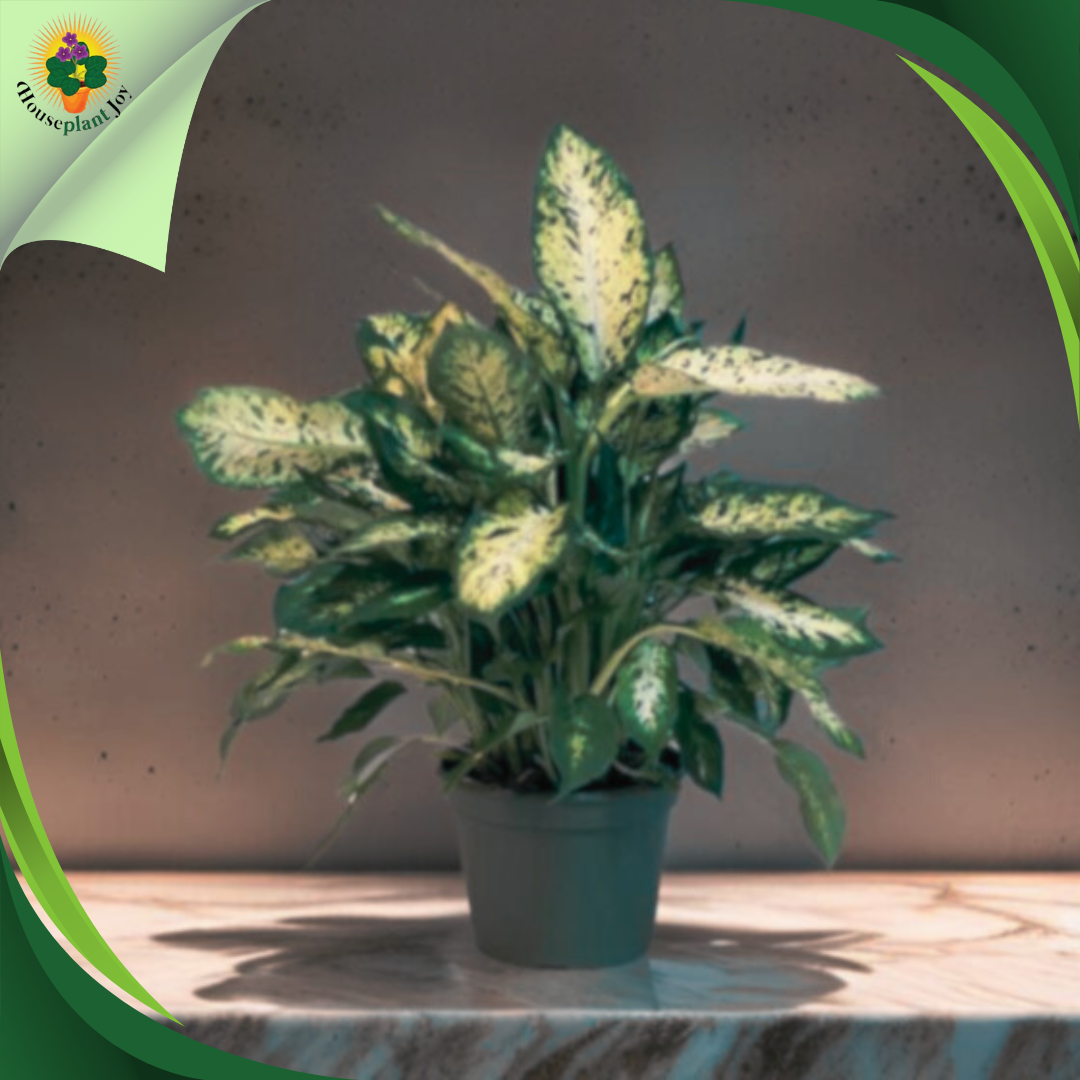HousePlantJoy is supported by our audience. When you purchase through one of our links, we may earn a small affiliate commission. As an Amazon Associate I earn from qualifying purchases. Your cost is not affected.
==================
Even the greenest thumbs encounter plant problems. From yellowing leaves to pesky pests, challenges are bound to arise. But fear not, plant parent! This guide is your roadmap to diagnosing and treating common Dieffenbachia ailments. Let’s dive in and equip you with the knowledge to keep your plant thriving. Together, we’ll uncover the secrets to a happy and healthy Dieffenbachia. Are you ready? Let’s get started!
Dieffenbachia Problems and Solutions: Quick Fixes for Common Issues
Dieffenbachia plants, beloved for their lush, variegated leaves and robust nature, are popular indoor beauties. However, even these hardy plants can encounter issues that require attention. From yellowing leaves to rotting roots, Dieffenbachias are not immune to common houseplant problems. Recognizing these issues early and knowing how to address them can help ensure your Dieffenbachia remains a vibrant and thriving part of your indoor garden. Let’s explore the most common problems and their solutions to keep your Dieffenbachia in top shape.
Proper watering, lighting, and pest control are key to keeping your Dieffenbachia happy. Most Dieffenbachia problems stem from water issues. Too much water can lead to root rot, while too little causes leaf drop. Finding the right balance is crucial.
Pests like spider mites and mealybugs can also bug your plant.
Regular checks and quick action can stop these pests in their tracks. With the proper care, your Dieffenbachia can thrive and add a touch of green to your space for years to come.
Species and Varieties
Dieffenbachia plants come in several species and cultivars. The most common is Dieffenbachia seguine, also called dumb cane. Other popular types include D. amoena and D. maculata. These plants have large, oval leaves with patterns of green, white, and yellow. Some varieties have cream or silver markings. Leaf sizes range from 6 to 24 inches long.
Popular cultivars include:
Growth Requirements
Dieffenbachia plants need specific care to thrive indoors. They prefer bright, indirect light but can tolerate low light. Direct sun can burn their leaves. Water your dieffenbachia when the top inch of the soil feels dry. These plants like humidity, so mist them often or use a pebble tray.
Keep temperatures between 60-75°F (15 and 24°C). Use well-draining potting soil and fertilize monthly during the growing season. Repot your plant every 2-3 years. Prune to control size and remove yellow leaves. Be careful when handling, as the sap can cause skin irritation.
Common Problems in Dieffenbachia Care
Dieffenbachia plants, despite their hardiness, can face several care challenges. The most common issues stem from improper watering and lighting conditions. By recognizing the early signs of distress, you can address these problems promptly and ensure your Dieffenbachia remains healthy and vibrant.
Overwatering Issues
Overwatering is a common problem for Dieffenbachia plants. Symptoms include yellowing leaves, soggy soil, and a mushy stem, all indicating that your plant is receiving excessive water. Addressing this problem promptly can help restore your Dieffenbachia’s health and prevent further damage.
To fix this:
- Let the soil dry out between waterings
- Check for proper drainage in your pot
- Reduce watering frequency, especially in winter
If the problem persists, you might need to repot your plant. Use fresh, well-draining soil mix. Remove any rotten roots before replanting.
Underwatering Signs
Underwatering presents a distinct set of symptoms in Dieffenbachia plants. Look for:
- Drooping or wilting leaves
- Dry, crispy leaf edges
- Slow growth
To address underwatering:
- Water more frequently, ensuring even distribution throughout the soil
- Use a moisture meter for accurate watering
Brown leaf tips can result from both underwatering and low humidity. To increase moisture, mist your plant regularly or use a pebble tray.
Lighting Troubles
Dieffenbachia requires the right balance of light to thrive, as both excessive and insufficient light can lead to problems.
Signs of too much light:
- Pale or bleached leaves
- Scorched patches on leaves
Signs of not enough light:
- Drooping leaves
- Slow or stunted growth
- Loss of variegation in leaves
For optimal results, place your Dieffenbachia in bright, indirect light. Avoid direct sunlight, which can scorch the leaves. If your plant is near a window, use a sheer curtain to filter the light. This will ensure your Dieffenbachia gets the ideal amount of light for healthy growth and vibrant foliage.
Fungal Infections
Fungal problems are common in Dieffenbachia. Leaf spots are a frequent issue. You’ll see brown or black spots on the leaves. To fix this:
- Remove affected leaves
- Improve air circulation
- Avoid overwatering
Root rot is another fungal disease. It happens when the soil stays too wet. Signs include yellowing leaves and soft, brown roots. To treat:
- Remove the plant from its pot
- Cutaway rotted roots
- Repot in fresh, well-draining soil
Use a fungicide if needed. Always sterilize your tools before pruning to prevent spread.
Bacterial Diseases
Bacterial leaf spots can harm DieffenbachiaDieffenbachia. You’ll notice water-soaked spots on leaves that turn brown or black. To manage this:
- Remove infected parts
- Avoid overhead watering
- Keep leaves dry
Bacterial soft rot affects stems. It causes mushy, smelly stems. If you see this:
- Cut out affected areas
- Let the cut dry before watering
- Use a bactericide if needed
Good airflow and proper watering help prevent bacterial issues.
Viral Pathogens
Viruses in DieffenbachiaDieffenbachia are hard to treat. Common symptoms include:
- Mosaic patterns on leaves
- Stunted growth
- Leaf deformation
There’s no cure for plant viruses. Your best options are:
- Remove and destroy infected plants
- Control insects that spread viruses
- Buy virus-free plants from trusted sources
Prevention is key. Keep your tools clean and wash your hands between plants. This helps stop the virus spread.
Common Houseplant Pests
Spider mites are tiny pests that feed on plant sap. You’ll see fine webbing on leaves and stems. They can cause yellowing and wilting.
Mealybugs look like small white cotton balls on leaves and stems. They suck sap and weaken the plant. Thrips are slim insects that scrape plant tissue. Look for silvery patches on the leaves. Scale insects form hard, bump-like shells on stems and leaves. They drain plant juices and cause yellowing.
Preventative Measures
Check your Dieffenbachia regularly for signs of pests. Wipe down leaves with a damp cloth to remove dust and potential pests. Keep your plant healthy with proper watering and light. Healthy plants resist pests better.
Isolate new plants for a week or two before putting them near others. This stops pests from spreading. Use sterile potting soil and clean pots when repotting to avoid introducing pests.
Treatment Options
For light infestations, remove pests by hand or with a cotton swab dipped in rubbing alcohol. Spray affected areas with a mix of water and mild dish soap. This suffocates small pests. Neem oil is a natural insecticide that works well on many pests. Apply it to all plant surfaces.
For severe cases, use a chemical insecticide made for indoor plants. Follow the label instructions carefully. Repeat treatments weekly until all signs of pests are gone. Be patient; it may take several applications to solve the problem fully.
Identifying Deficiencies
Yellowing leaves often point to nutrient problems in Dieffenbachia. If the whole leaf turns yellow, it may lack nitrogen. Iron deficiency causes young leaves to turn yellow while veins stay green.
Pale or stunted growth can mean a lack of phosphorus. Potassium shortages lead to brown leaf edges and weak stems. Watch for purple tints on leaves, which may signal phosphorus issues. Calcium deficiency can cause new leaves to be small and misshapen.
Correcting Imbalances
To fix nutrient problems, start by checking your watering and soil. Overwatering can cause drooping and nutrient issues. Make sure your pot has good drainage. Use a balanced, water-soluble fertilizer every 2-3 weeks during growing season. Dilute it to half-strength to avoid burning the roots.
If you suspect a specific deficiency:
- For nitrogen: Add compost or a nitrogen-rich fertilizer
- For iron: Use an iron supplement or chelated iron
- For calcium: Mix crushed eggshells into the soil
If the soil is old and depleted, repot your plant. Fresh potting mix can provide a boost of nutrients. Aim to repot every 2-3 years or when the plant outgrows its container.
Temperature Extremes
Dieffenbachia thrives in warm conditions, ideally between 60-75°F (15-24°C). Cold drafts and temperatures below 50°F (10°C) can stress the plant, leading to:
- Drooping leaves
- Brown spots
- Slow growth
To protect your Dieffenbachia from the cold:
- Move it to a warmer location.
- Use a space heater if necessary.
- Cover the plant with a blanket at night.
Conversely, high temperatures can also be problematic. If the plant is exposed to excessive heat, its leaves may turn yellow.
To prevent this:
To increase humidity
- Mist the leaves daily.
- Use a pebble tray filled with water beneath the plant.
- Group your plants together to create a microenvironment.
- Consider using a humidifier nearby.
Maintain steady humidity by keeping your plant away from drafts while ensuring good airflow. If you live in a humid area, watch for fungal growth on the leaves. If needed, improve air circulation around the plant with a small fan.
By managing these environmental factors, you can help your Dieffenbachia flourish and maintain its attractive appearance.
When to Repot
Repot your Dieffenbachia every 2-3 years to keep it healthy. Signs that it’s time to repot include:
- Roots growing out of the drainage holes
- The plant becoming top-heavy or unstable
- Soil dries out quickly after watering
- Slowed growth
Spring is the ideal time for repotting, as the plant is entering its active growing season. Prompt repotting prevents root-bound issues that can harm your plant.
How to Repot Safely
- Choose the Right Pot:
- Select a pot that is 1-2 inches larger in diameter than the current one.
- Prepare the Potting Mix:
- Use a well-draining potting mix to promote healthy root growth.
- Remove the Plant:
- Take the plant out of its current pot, and be careful not to damage the roots.
- Prepare the Roots:
- Loosen the root ball and trim any damaged or rotting roots.
- Replant:
- Place the plant in the new pot at the same depth it was previously. Fill in with fresh potting mix and water thoroughly.
- Handle with Care:
Here’s how to effectively prune your Dieffenbachia:
- Remove Dead or Dying Leaves:
- Cut back dead or unhealthy leaves where they meet a healthy stem. This helps prevent disease spread and enhances the plant’s overall appearance.
- Encourage Bushier Growth:
- Trim long or leggy stems just above a leaf node. This promotes new growth and encourages a fuller, bushier plant.
- Reduce Height:
Regular pruning leads to a denser, stronger plant and helps maintain its shape and size. Always use clean, sharp tools to minimize the risk of infection and ensure cleaner cuts.
After pruning, your Dieffenbachia might look a bit bare, but don’t worry—new growth will soon appear, making your plant fuller and more vibrant.
Cuttings
Stem cuttings are a popular and effective method for propagating this stunning houseplant.
Here’s a simple guide:
- Prepare your cutting: Choose a healthy stem and cut it into 3-inch sections, ensuring each piece has at least one leaf node. Remove lower leaves.
- Rooting options: You can root your cuttings in water or soil. For water propagation, place the cutting in a clean glass and change the water regularly. For soil propagation, use a well-draining mix and dip the cut end in the rooting hormone before planting.
- To provide optimal conditions, Place your cuttings in bright, indirect light. Keep the soil or water moist but not soggy.
- Patience is vital: Roots should develop within a few weeks. Once they’re an inch long, transplant water-rooted cuttings into the soil.
With a little care, you’ll soon have new Dieffenbachia plants to adorn your home.
Division
Division is an effective way to propagate Dieffenbachia, especially for mature plants with multiple stems. Here’s how to do it:
- Prepare the Plant:
- Gently remove the Dieffenbachia from its pot and shake off excess soil to reveal the root system.
- Examine the root ball for natural divisions or clusters.
- Divide the Plant:
- Carefully separate the plant into smaller sections using clean, sharp scissors or a knife. Each section should include healthy roots and at least one stem with leaves.
- Replant:
- Place each division into a new pot with fresh, well-draining soil.
- Water the new plants thoroughly and position them in a location with bright, indirect light.
- Post-Division Care:
- Keep the soil consistently moist while the new plants are established.
- Avoid direct sunlight, as it can scorch the leaves.
Following these steps, you can successfully propagate your Dieffenbachia and enjoy more of these beautiful plants.
Leaf Cleaning:
- Clean the leaves monthly to keep them dust-free and vibrant.
- Use a soft, damp cloth to wipe the leaves gently. Plain water is usually sufficient; add a drop of mild dish soap to the water for stubborn dirt.
- Avoid harsh chemicals which can damage the leaves.
Pruning:
- Use clean, sharp scissors or pruning shears.
- Remove damaged or yellowing leaves at the base of the stem.
- Prune during the growing season for quicker recovery, and avoid removing more than one-third of the plant at once.
- Trim brown leaf tips with sterilized scissors to maintain the plant’s natural shape and improve its appearance.
Pest Management:
- Regularly check for pests.
- If you find any, use a cotton swab dipped in rubbing alcohol to wipe the affected areas gently.
Repotting:
- Repot your Dieffenbachia every 2-3 years or when it outgrows its pot.
- Choose a pot that is 1-2 inches larger in diameter and has suitable drainage holes.
Rotation:
- Rotate your plant occasionally to ensure even light exposure, which promotes balanced growth.
Following these tips can keep your Dieffenbachia healthy, attractive, and thriving.
Fun Facts
Did you know that Dieffenbachia is often called “dumb cane” due to its toxic sap? This nickname comes from the plant’s potential to cause temporary paralysis of the vocal cords if ingested. It’s not just a concern for people—Dieffenbachia can also harm pets, causing severe health issues if they chew on or consume any part of the plant. Always handle your Dieffenbachia with care and keep it out of reach of children and pets to avoid any risks.
Dieffenbachia Problems and Solutions: Your Ultimate Care Guide
Maintaining a healthy Dieffenbachia requires addressing common issues such as improper watering, inadequate lighting, and pest infestations. By recognizing the early signs of stress and responding with informed care, you can keep your plant thriving and enhance your space with its lush, vibrant foliage.
Ensure you provide the right balance of water, light, and humidity to prevent problems before they start. Regularly inspect your plant for signs of distress and take swift action to resolve any issues. Remember, prevention is key to long-term success, so focus on creating and maintaining optimal care conditions.
Ready to put these tips into practice? Start by assessing your Dieffenbachia’s current care routine and make any necessary adjustments. Share your progress and any questions you may have with our community—we’re here to help you every step of the way. Transform your Dieffenbachia care and enjoy a flourishing plant today!
Why are the leaves of my Dieffenbachia turning brown and crispy?
Brown and crispy leaves often mean your plant is not getting enough water. Water your Dieffenbachia when the top inch of the soil feels dry. Make sure the pot has good drainage to avoid root rot. Low humidity can also cause this issue. To increase moisture around the plant, try misting the leaves or using a pebble tray.
How can I prevent yellowing and dropping leaves in my Dieffenbachia plant?
Yellow leaves can be a sign of overwatering or poor drainage. Check that your pot has drainage holes and use well-draining soil. Too much direct sunlight can also cause yellowing. Move your plant to a spot with bright, indirect light.
What could be causing my Dieffenbachia plant to wilt or look unhealthy?
Wilting can be due to underwatering or overwatering. Check the soil moisture and adjust your watering schedule. Cold drafts or temperatures below 60°F (15°C) can also cause wilting. Keep your plant in a warm spot away from drafty windows or doors.
What are some effective treatments for common pests found on Dieffenbachia plants?
Wipe leaves with a damp cloth or use insecticidal soap for spider mites or mealybugs. Neem oil is effective against many pests. Apply it every 7-14 days until the problem is gone.
Is Dieffenbachia poisonous, and how can I safely care for it?
Yes, Dieffenbachia is toxic if ingested. The sap can cause irritation and temporary speechlessness. Wear gloves when handling the plant. Keep it out of reach of children and pets.
How can I rejuvenate a Dieffenbachia plant that appears to be dying?
Prune away any dead or yellowing leaves. Then, check for pests and treat if necessary. If the plant has been in the same pot for a long time, repot it in fresh soil and adjust your watering and lighting to match its needs.
